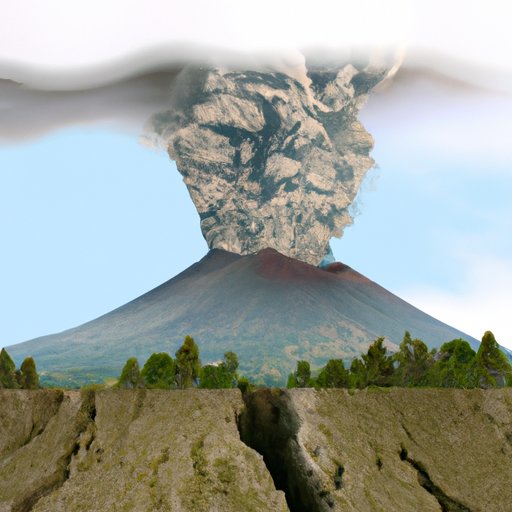Introduction
A volcano is a vent in Earth’s surface that allows molten rock, ash and gases to escape from below the surface. Volcanic eruptions can be incredibly destructive, leading to loss of life and property damage. In this article, we will explore the science behind the world’s most hazardous volcanoes and rank the most destructive eruptions in history. We will also discuss how to prepare for a volcanic eruption and examine the risk of living near an active volcano.
The Science Behind the World’s Most Hazardous Volcanoes
Volcanic activity is caused by the movement of Earth’s tectonic plates, which form the planet’s outer shell. When two plates move apart or one plate slides beneath another, molten rock called magma rises from the mantle and collects in pockets between the plates. This magma can build up pressure until it eventually erupts through the Earth’s surface, creating a volcano.
Volcanic eruptions can be classified into three different types: effusive, explosive and phreatomagmatic. Effusive eruptions are relatively gentle and involve the slow release of lava from the volcano. Explosive eruptions occur when pressure builds up inside the volcano and the magma is violently ejected into the atmosphere. Phreatomagmatic eruptions are caused by the interaction between magma and water, resulting in a powerful steam explosion.

Ranking the Most Destructive Volcanic Eruptions in History
Throughout history, there have been many devastating volcanic eruptions. Here are some of the most destructive eruptions ever recorded:
Pompeii, Italy (79 AD)
The eruption of Mount Vesuvius in 79 AD buried the Roman city of Pompeii under a thick layer of ash and pumice. The eruption killed an estimated 16,000 people, making it one of the deadliest eruptions in human history.
Mount Tambora, Indonesia (1815)
The eruption of Mount Tambora in 1815 was one of the most powerful eruptions in recorded history. The blast caused a global climate anomaly known as the “Year Without a Summer”, leading to widespread crop failures and famine.
Krakatoa, Indonesia (1883)
The eruption of Krakatoa in 1883 created a massive tsunami that destroyed over 165 villages and killed more than 36,000 people. The blast was so loud that it could be heard 3,000 miles away.
Mount St. Helens, USA (1980)
The eruption of Mount St. Helens in 1980 was the deadliest and most economically destructive eruption in US history. The blast killed 57 people and caused over $1 billion in damage.
Nevado del Ruiz, Colombia (1985)
The eruption of Nevado del Ruiz in 1985 triggered a massive mudflow that buried the town of Armero, killing an estimated 23,000 people. It was the second-deadliest volcanic disaster in recorded history.
How to Prepare for a Volcano Eruption: What You Need to Know
Living near an active volcano can be risky, but there are measures you can take to stay safe in the event of an eruption. Understanding the warning signs of an imminent eruption is key to staying prepared. Common warning signs include increased seismic activity, swelling of the volcano’s summit, and changes in gas emission rates.
It’s also important to develop an emergency plan for you and your family. Make sure to identify evacuation routes, establish a meeting place, and stock up on necessary supplies such as food, water, and first aid kits. It’s also a good idea to keep important documents such as passports and birth certificates in a waterproof container.
Exploring the Geology of the World’s Most Dangerous Volcanoes
The world’s most dangerous volcanoes vary in terms of their location, shape, magma type and composition, and the gases and ash they emit. For example, some volcanoes are located close to densely populated areas, while others are situated in remote regions. Some volcanoes are highly symmetrical, while others have irregular shapes due to previous eruptions.
The type of magma contained inside a volcano also plays a role in its potential for destruction. Magma that contains a high amount of dissolved gas is more likely to produce violent eruptions than magma with lower gas content. Volcanic gases such as carbon dioxide and sulfur dioxide can be hazardous to humans, while volcanic ash can cause respiratory problems and reduce visibility.

Examining the Risk of Living Near an Active Volcano
Living near an active volcano can be risky, especially if you don’t understand the potential for damage. It’s important to assess the potential hazards posed by the volcano and identify evacuation routes in the event of an eruption. You should also familiarize yourself with the insurance implications of living near a volcano, as some insurers may not cover losses caused by volcanic activity.

Investigating the Effects of Volcanic Eruptions on the Environment
Volcanic eruptions can have a significant impact on the environment, from air quality to local wildlife. Eruptions can release large amounts of sulfur dioxide and other gases into the atmosphere, leading to acid rain and air pollution. Ash and debris can also affect nearby ecosystems, burying vegetation and contaminating water sources.
Eruptions can also cause changes to the terrain, such as landslides and mudflows. These events can destroy roads and buildings, and can even trigger tsunamis if they occur near bodies of water.
Conclusion
Volcanic eruptions can be incredibly destructive, leading to loss of life and property damage. In this article, we explored the science behind the world’s most hazardous volcanoes and ranked the most destructive eruptions in history. We also discussed how to prepare for a volcanic eruption and examined the risk of living near an active volcano.


